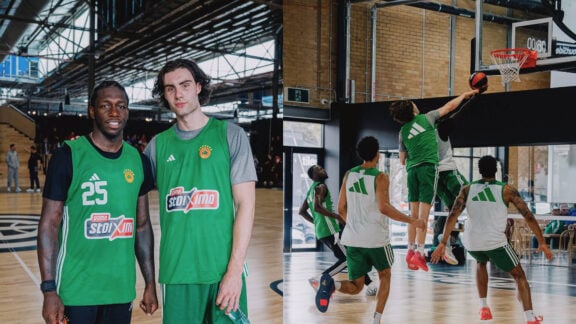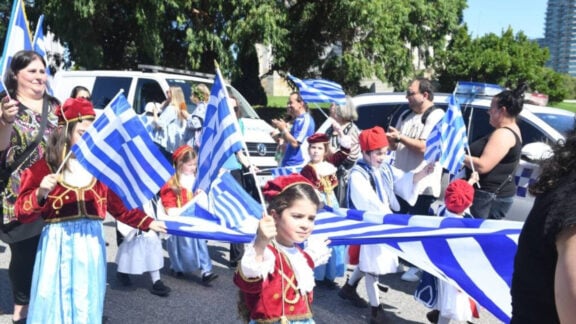I had the pleasure of speaking with Greek campaign veteran Arthur Leggett on 8 September 2021, on the occasion of his 103rd birthday. Arthur is a legend amongst Australia’s Cretan and wider Hellenic community. Today we remember Mr Leggett’s service and his part in the campaign to defend Greece against the Axis invasion of April-May 1941.
As a young steelworker Mr Leggett took up the challenge of enlisting in the 2nd Australian Imperial Force, joining as a signalman in the 2/11th Battalion. After taking part in the great Australian victories of early 1941 in North Africa, Mr Leggett was sailing to Greece. Approaching the bombed and battered harbor of Piraeus in early April 1941, Mr Leggett remembers seeing the Acropolis from the sea. He says that he recognised the Parthenon from picture books he’d seen and thought to himself “Gee, ay? There it is”.

Unlike other Australians who enjoyed some leave in Athens, his unit was moved north after only a short stay at the Allied camp at Daphne, then on the outskirts of Athens. He was soon taking part in the Allied defence of mainland Greece, arriving at Kalabaka on 14 April, beneath the magnificent hill-top monasteries of Meteora.
Mr Leggett remembers then taking part in the defence of Brallos Pass, where a memorial was erected only a few years ago. After all these years, Mr Leggett recalls the battle, the mortar shells as the Australians held up the German advance. The job of Mr Leggett and his fellow Battalion signalmen was to keep the telephone communications open between the various companies and their headquarters. This could be a dangerous job. Mr Leggett recalls how 20-year-old Signalman Ray Kennedy dashed out from cover and repaired a line under heavy fire, restoring communications during the battle. Ray was subsequently awarded the Military Medal for his “complete disregard for [his] own safety and devotion [at] BRALOS.”
READ MORE: Australian Nurses, Anzac centenary honoured in Adelaide

Others in Mr Leggett’s unit would not be so fortunate, four were killed and 11 wounded. One of the latter was 29-year-old Private Dan Smith from Perth. Mr Leggett recalls that Dan was over 6 feet tall and was badly wounded by a burst of machine-gun fire as the Germans advanced through the pass. He was soon captured and Dan’s service record reveals that the Germans took him to a hospital at Lamia, where he later succumbed to his wounds on 1 May. He is buried at Athens’ Phaleron War Cemetery.
One of Mr Leggett’s overwhelming recollections from his experience of the defence of the Greek mainland was of being subjected to German air attack throughout the daylight hours. As he recalls “we were bombed, we were strafed, all the way down Greece.”As they moved south in trucks, one of the men would keep an eye out for on-coming German planes, and when one was spotted, they’d stop and pile out, spreading out as far as they could on each side of the road, flattened to the ground in the “hope that you were going to survive this one” in Mr Leggett’s words. He also recalled the withdrawal through Larissa and seeing the devastation wreaked by the “horrendous” German bombing raids on the villages and town of Greece.

After Brallos, Mr Leggett and the Battalion withdrew eight miles to Megara on the coast, suffering more casualties along the way, arriving late in the evening of 24 April. One of Mr Leggett’s Battalion officers recalls enjoying “some coffee and cognac” with the local policeman in the town. After a rest in olive groves, they boarded their transports on the evening of Anzac Day and sailed in a convoy to Crete. When they came aboard Mr Leggett recalls being “dog tired … completely exhausted.”
Mr Leggett remembers the terrible journey to Crete, with the ship subjected to German air attack after daybreak for eight hours. The Battalion’s new commander – English-born 31-year-old Major Ray Sandover – had the battalion’s Bren guns mounted on the ships railings to help defend the ship. Mr Leggett recalls the men bringing “down quite a few planes purely with Bren Gun fire.” A photo from the time shows Australian soldiers aboard another Allied transport on its way to Crete doing the same thing.

The Battalion arrived safely at Crete’s Souda Bay in the late afternoon of 26 April. Camped near the harbour, Mr Leggett recalls enjoying a good meal (including a Freddo Frog!) before collapsing into a well-earned sleep after the stress of the previous days. They soon moved to a new camp near the village of Nea Chorio, to Georgioupoli on 5 May and then on 9 May occupying defensive positions in olive groves above the airfield at Rethymno. Another digger who camped at Nea Chorio was Victorian Private Syd Grant, who photographed the village in May 1941.
Mr Leggett was now part of a combined Australian, British and Greek force that would successfully defend the airfield and surrounds from the German air assault that began on 20 May and lasted for ten ferocious days. Mr Leggett recalls it as a “nasty battle”, the bitter fight at the Perivolio olive factory dead lying all over the battlefield, with many casualties being inflicted on both sides. Mr Leggett survived the battle but one of his comrades did not. 23 year old farmhand from Beverley Private Reginald Mayerwas killed on the first day. He is buried in the Suda Bay War Cemetery.
With the defeat and withdrawal of the Allied defender to the west and bracing for a coming German onslaught, Mr Leggett took the advice of Major Sandover and opted to evade capture. Along with 20 others he made his way across what he called the “razorback of mountains” on goat tracks led by a Cretan shepherd. Arriving at a bay on the south coast, they waited for evacuation.
Some of his battalion did escape Crete but not Mr Leggett. Lacking food, water and ammunition with no evacuation in sight, Mr Leggett would soon be taken prisoner by German troops who reached their camp. He was now a prisoner of war. Mr Leggett described the initial trek back across Crete and his experience in the Chania Prison, where they were kept for several weeks. Like many other POW’s he recalls how their initial captors showed no violence towards their prisoners, being frontline soldiers too. The situation changed at Chania and after. Their German guards were “mongrel bastards” in Mr Leggett’s words, older men with Hitler moustaches, who would shoot you at the drop of a hat.
They were then sent by sea to Thessaloniki, crammed into the stinking, dirty hold of former coal ship. He recalls arriving at the harbor front and being marched through the city to the old barracks re-purposed as a POW camp by the Germans. On the way, Mr Leggett again witnessed the cruelty of his German guards, this time meted out to local civilians who tried to offer the starving prisoners some food.
Mr Leggett’s memory of this POW camp concurs with other accounts. It was a filthy, unhealthy and dangerous place to be held. The barracks were invested with vermin, with no windows, doors or bunks, only the cold cement floor for a bed and fed inadequate food. During the day the men would endure day-long parades in the open. At night, those who needed to go outside to the open latrines would have to run the gauntlet of the potshots of the German guards.
This would be the end of Mr Leggett’s time in Greece. Thessaloniki’s POW camp would close, Mr Leggett sent by train to other camps based in Germany. He would survive work in Polish coalmines and the final death marches of 1944/45, be liberated and return to his home in Perth.
Mr Leggett’s service – and that of his comrades – at the battle of Rethymno is commemorated in the magnificent memorials that have been erected in the town that they defended in May 1941, the Hellenic Australian Memorial in Rethymno town and the Stavromenos Memorial, just to the east of the town. It had been my pleasure to have been able to attend the annual services at these memorials.

Mr Leggett is a regular attendee and honored guest at both Anzac Day and Greek campaign commemorative events in Perth, reading the Ode at his local high school who has named their library in his honour. In April earlier this year he read the Ode at the annual Len Hall Memorial AFL game in Fremantle. He has made the long journey to Melbourne on many occasions, the honoured guest of Melbourne’s Cretan community and Battle of Greece and Crete Commemorative Council. He has visited the two olive trees planted in honour of the Battle of Crete, at the Shrine and in Pascoe Vale.
As Mr Leggett said to me he is proud to be an honorary member of both Perth and Melbourne’s Greek communities. I know that all will join with me in wishing Mr Leggett a happy birthday and many more to come. As I said to him on the phone – Xronia Pola Mr Leggett!
Jim thanks Nick Rerakis for helping with this article. Nick is a good friend and host to Mr Leggett when he has visited Melbourne over the years. He also acknowledges the work of the University of NSW and its Australian at War Film Archive in the preparation of this article.








